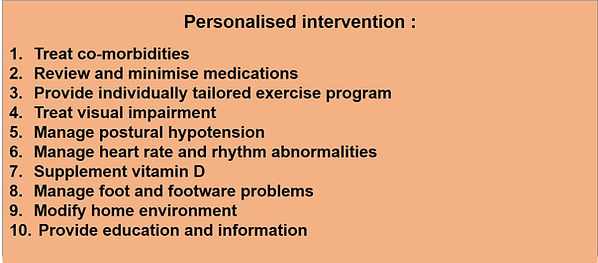
Resources for the Comprehensive Geriatric Assessment based
Proactive and Personalised Primary Care of the Elderly
Falls

Falls are common in older people with 30% of those older than 65 and 50% of those older than 80 falling at least once a year. NICE guidance recommends asking older people routinely whether they have fallen in the past year.
A multifactorial risk assessment should be performed for all individuals aged 65 and older who present with :
-
Request for medical attention following a fall
-
Two or more falls in the past 12 months
-
Difficulty with walking or balance

Timed Chair Stand Test
Strength and endurance test in the assessment of sarcopenia (risk of falls)
3 min.
4 Stage Balance Test
Assessment of static balance in the assessment of sarcopenia (risk of falls)
3 min.
Timed Up and Go test
Assessment of mobility, balance, walking ability, and fall risk in older adults
10 min.
Gait Speed Test (4 metre)
Simple assessment of functional mobility
5 min.
Activities-specific Balance Confidence scale
Self-report measure of balance confidence in performing various activities without losing balance or experiencing a sense of unsteadiness.
10 min.
Berg Balance Scale
Healthcare provider administered assessment to determine a person’s balance abilities
20 min.
Dizziness Hanadicap Inventory
Self-report of the handicapping effects of dizziness
10 min.
Epidemiology
Falls rate amongst the leading cause of external injury (Burt CW,1998).
Elderly persons who fall are 10 times more likely to be hospitalized and eight times more likely to die as the result of a fall (Runge JW, 1993).
Trauma is the fifth leading cause of death in persons more than 65 years of age, and falls are responsible for 70% of accidental deaths in persons 75 years of age and older (Weigelt JA 1997).
The number of falls increases progressively with age in both sexes and all racial and ethnic groups (Tibbits GM 1996).
The injury rate for falls is highest among persons 85 years of age and older (Sattin RW,1992).
Elderly persons who survive a fall experience significant morbidity.
Hospital stays are almost twice as long in elderly patients who are hospitalized after a fall than in elderly patients who are admitted for another reason (Dunn JE, 1992).
Compared with elderly persons who do not fall, those who fall experience greater functional decline in activities of daily living (ADLs) and in physical and social activities (Kiel DP, 1991) and they are at greater risk for subsequent institutionalization (Tinetti ME, 1993).
Falls and concomitant instability can be markers of poor health and declining function (Tinetti ME, 1995).
In older patients, a fall may be a non-specific presenting sign of many acute illnesses, such as pneumonia, urinary tract infection or myocardial infarction, or it may be the sign of acute exacerbation of a chronic disease (Rabin DW, 1995).
About one third of community-dwelling elderly persons and up to 60 percent of nursing home residents fall each year; one half of these “fallers” have multiple episodes (Hirsch CH, 1990).
Major injuries, including head trauma, soft tissue injuries, fractures and dislocations, occur in 5% to 15% of falls (King MB, 1996).
More than 90% of hip fractures are associated with falls, and most of these fractures occur in persons more than 70 years of age (Capezuti E, 1996).
Hip fracture is the leading fall-related injury that results in hospitalization, with these hospital stays being significantly prolonged and costly (Mahoney JE, 1998).
One fourth of elderly persons who sustain a hip fracture die within six months of the injury.
More than 50% of older patients who survive hip fractures are discharged to a nursing home, and nearly one half of these patients are still in a nursing home one year later (Coogler CE, 1999).
Hip fracture survivors experience a 10% to 15% decrease in life expectancy and a meaningful decline in overall quality of life.
Most falls do not end in death or result in significant physical injury.
However, the psychological impact of a fall or near fall often results in a fear of falling and increasing self-restriction of activities.
The fear of future falls and subsequent institutionalization often leads to dependence and increasing immobility, followed by functional deficits and a greater risk of falling.
AGS/BGS Clinical Practice Guideline Prevention of Falls in Older Person (2010)




Falls is one of 4 conditions identified as
Geriatric Syndromes
Back To : Geriatric Syndromes

